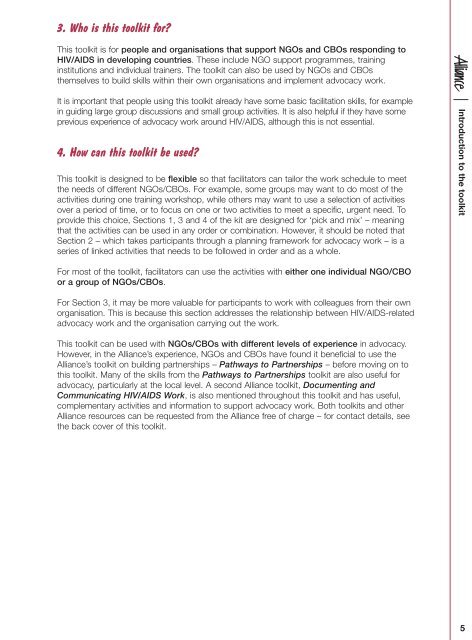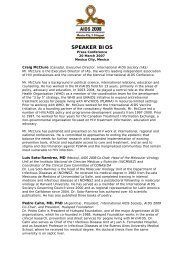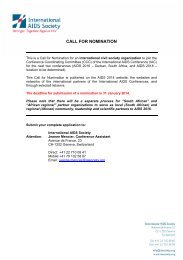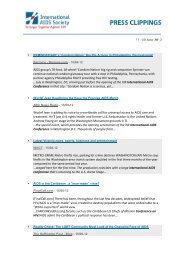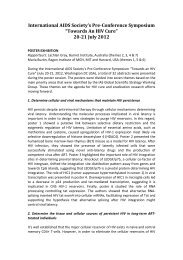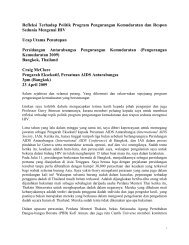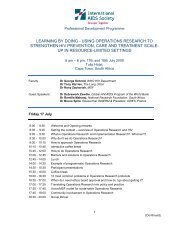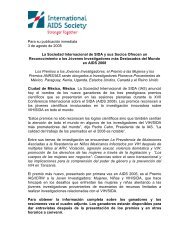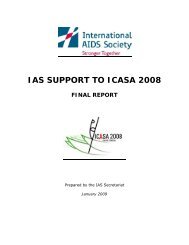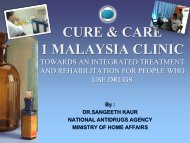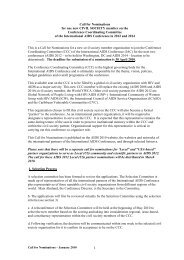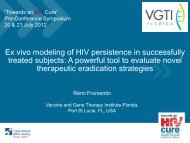Advocacy in Action - International AIDS Society
Advocacy in Action - International AIDS Society
Advocacy in Action - International AIDS Society
You also want an ePaper? Increase the reach of your titles
YUMPU automatically turns print PDFs into web optimized ePapers that Google loves.
3. Who is this toolkit for?<br />
This toolkit is for people and organisations that support NGOs and CBOs respond<strong>in</strong>g to<br />
HIV/<strong>AIDS</strong> <strong>in</strong> develop<strong>in</strong>g countries. These <strong>in</strong>clude NGO support programmes, tra<strong>in</strong><strong>in</strong>g<br />
<strong>in</strong>stitutions and <strong>in</strong>dividual tra<strong>in</strong>ers. The toolkit can also be used by NGOs and CBOs<br />
themselves to build skills with<strong>in</strong> their own organisations and implement advocacy work.<br />
It is important that people us<strong>in</strong>g this toolkit already have some basic facilitation skills, for example<br />
<strong>in</strong> guid<strong>in</strong>g large group discussions and small group activities. It is also helpful if they have some<br />
previous experience of advocacy work around HIV/<strong>AIDS</strong>, although this is not essential.<br />
4. How can this toolkit be used?<br />
This toolkit is designed to be flexible so that facilitators can tailor the work schedule to meet<br />
the needs of different NGOs/CBOs. For example, some groups may want to do most of the<br />
activities dur<strong>in</strong>g one tra<strong>in</strong><strong>in</strong>g workshop, while others may want to use a selection of activities<br />
over a period of time, or to focus on one or two activities to meet a specific, urgent need. To<br />
provide this choice, Sections 1, 3 and 4 of the kit are designed for ‘pick and mix’ – mean<strong>in</strong>g<br />
that the activities can be used <strong>in</strong> any order or comb<strong>in</strong>ation. However, it should be noted that<br />
Section 2 – which takes participants through a plann<strong>in</strong>g framework for advocacy work – is a<br />
series of l<strong>in</strong>ked activities that needs to be followed <strong>in</strong> order and as a whole.<br />
Introduction to the toolkit<br />
For most of the toolkit, facilitators can use the activities with either one <strong>in</strong>dividual NGO/CBO<br />
or a group of NGOs/CBOs.<br />
For Section 3, it may be more valuable for participants to work with colleagues from their own<br />
organisation. This is because this section addresses the relationship between HIV/<strong>AIDS</strong>-related<br />
advocacy work and the organisation carry<strong>in</strong>g out the work.<br />
This toolkit can be used with NGOs/CBOs with different levels of experience <strong>in</strong> advocacy.<br />
However, <strong>in</strong> the Alliance’s experience, NGOs and CBOs have found it beneficial to use the<br />
Alliance’s toolkit on build<strong>in</strong>g partnerships – Pathways to Partnerships – before mov<strong>in</strong>g on to<br />
this toolkit. Many of the skills from the Pathways to Partnerships toolkit are also useful for<br />
advocacy, particularly at the local level. A second Alliance toolkit, Document<strong>in</strong>g and<br />
Communicat<strong>in</strong>g HIV/<strong>AIDS</strong> Work, is also mentioned throughout this toolkit and has useful,<br />
complementary activities and <strong>in</strong>formation to support advocacy work. Both toolkits and other<br />
Alliance resources can be requested from the Alliance free of charge – for contact details, see<br />
the back cover of this toolkit.<br />
5


